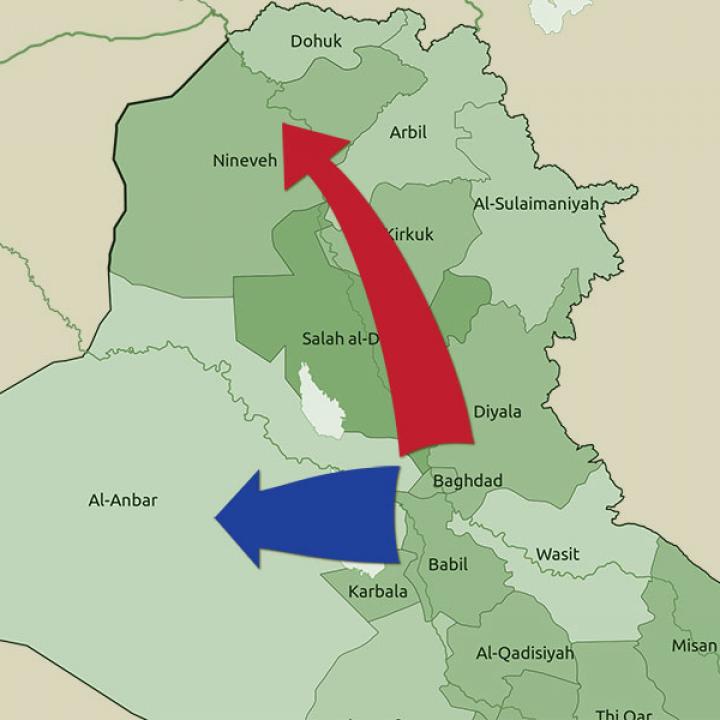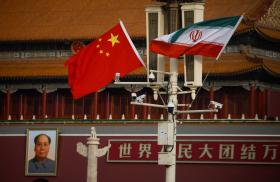
- Policy Analysis
- Articles & Op-Eds
Anbar First, Mosul Never? Iraq's Strategy for Defeating ISIS

Since regaining Tikrit, the Iraqi government has seemingly listened to Washington's advice about delaying an undermanned campaign to retake Mosul, focusing instead on marshalling sufficient cross-sectarian forces in western Anbar province.
When Ramadi fell to the Islamic State (also called ISIS) on May 17, many believed that it was a turning point in the campaign in Iraq, redirecting the war west toward the Anbar province and away from ISIS' capital in Mosul, in Iraq's north. In fact, the pivot toward Anbar has been months in the making; the fall of Ramadi, on the eastern edge of Anbar, was actually ISIS beating the coalition to the punch.
SHOWDOWN IN ANBAR
Ever since April 2, when ISIS was evicted from Tikrit, a Sunni city between Mosul and Baghdad, ISIS knew to expect a government offensive in Anbar. The tough battle of Tikrit (a city with a tenth of Mosul's landmass), which went on for nearly 45 days and left hundreds dead, underlined the fact that the government probably could not retake Mosul and end the war against ISIS anytime soon, due to the slow rollout of new U.S.-equipped Iraqi security forces (ISF) units, and so it would look elsewhere.
It wasn't surprising, then, when on April 8, Iraqi Prime Minister Haider al-Abadi went to Habbaniyah, the same Anbar army base now serving as the launchpad for the re-conquest of Ramadi, and announced "now we turn to the west." Abadi was throwing down the gauntlet in Anbar.
Abadi used the visit to draw Sunni Arab volunteers into the primarily Shia Hashd al-Shaabi (Popular Mobilization Units). With his fleeting post-Tikrit boost in political capital, he wanted to shape the PMUs into a cross-sectarian force that might serve national goals rather than those of Abadi's political rivals, the Iranian-backed leaders of many of the PMUs, whom I wrote about in my last piece for Foreign Affairs, "Iraq's Bekaa Valley."
In meetings with U.S. political and defense officials in Washington, DC in mid-April, Abadi confirmed the pivot to Anbar. He and U.S. officials agreed to prioritize the province over Mosul as a way to score near-term victories with the forces available to Iraq now, as well as to try out the kind of government-Sunni collaboration that would be needed to liberate and govern Sunni areas.
And so, as soon as the battle for Tikrit fully ended, large groups of Iraqi forces began to head west. On April 14, ISF and PMU troops began an offensive in Karma district, where easternmost Anbar meets Baghdad. On May 2, the advanced headquarters of the new Iraqi army 16th division -- the first fully functional new division to be graduated since the fall of Mosul -- was transferred to Anbar. Combat brigades began flowing to Anbar in mid-May, just before the fall of Ramadi.
At the same time, Shia units of the PMU also began to extend their operations westward from the Shia shrine city of Karbala, which borders Anbar. Shia PMUs have occupied the desert crossroads town of Nukhayb, a Sunni tribal stronghold, since August 2014 as a way to give flank protection for Karbala. The city, which was the subject of long-lasting territorial quibbles between the Anbar and Karbala Provinces, was transferred to the predominately Shia Karbala Province in mid-May to complete its incorporation into the Karbala defence scheme.
Reading the writing on the wall, ISIS' leaders then pulled out all the stops to blunt Iraqi momentum north of Tikrit and in Anbar. On April 27, ISIS Caliph Abu Bakr al-Baghdadi issued a communique that called on Syria-based fighters to surge toward the battlefields of Iraq, specifically the provinces of Salah ad-Din (where Tikrit is located) and Anbar. According to Iraqi military officers in Ramadi, four hundred trucks of ISIS reinforcements were split evenly between the two battlegrounds.
Following the fall of Ramadi to ISIS on May 17, all eyes are now on Anbar, with counter-attacking forces being assembled from PMUs, and Iraqi army and Federal Police reinforcements released from Baghdad city's own strategic reserve.
ALL QUIET ON THE NORTHERN FRONT
Two weeks before ISIS' sucker punch in Ramadi, multiple U.S. government officials signaled to me that the battle for Mosul, victory in which would be necessary to defeat ISIS in Iraq, was slipping further into the distance. Liberation, it seemed, was looking increasingly unlikely in 2015.
For good reason. Since ISIS took Mosul last year, it has solidified its base there. ISIS' energetic late-April overrun of the Bayji refinery and the Hamrin oilfield, both astride the route to Mosul, created a bulwark against further government advances toward Mosul.
But behind these events are other more significant reasons why Iraqi government enthusiasm for the Mosul battle has waned. This story goes back to early in the Abadi premiership. At first, his government had decided to prioritize a knock-out blow in Mosul versus attritional fighting in Anbar. Symbolizing his decision was his pick for minister of defence in October 2014: When faced with a choice between a Sunni from Mosul (Khalid al-Ubeidi) and a Sunni from Anbar (Jaber al-Jabiri), Abadi pointedly chose the former.
The new Moslawi-led Iraqi military leadership was quite gung-ho about the prospect of regaining Mosul early on, particularly after the November 18, 2014 rescue of federal forces at Bayji refinery. But, even with Iraqi forces just one hundred miles south of Mosul and on a roll, Washington felt the need to temper Iraqi over-confidence that a rapid pencil-thin thrust up the Bayji-Mosul highway could burst the bubble of ISIS control in Mosul. Probably thankfully, the idea for a "thunder run" to Mosul faded away.
The Mosul-first mantra was still audible as recently as Abadi's February 16, 2015 interview with the BBC. In that interview, Abadi referred to Anbar as "contained" and reacted to questions about a Mosul offensive by providing a date range that spanned July-December 2015. He expressed hope that Mosul could be back under government control by the end of the year or "a bit sooner." What became increasingly clear over the spring, though, is that the forces required to liberate Mosul simply do not exist today and probably will not exist in 2015.
A quick run-through the options illustrates the problem. For one, Sunni factions do not seem capable of delivering a major Sunni force for Mosul's liberation. Unlike in Anbar, where strong tribal confederations facilitate rapid mobilization, the Moslawi political scene is atomized.
Urban Moslawis demonstrate very little cohesion. Atheel Nujaifi, Mosul's governor without a governorate, is raising small Mosul Liberation Force units in neighboring Kurdistan. But these are not game-changers. Hundreds of thousands of military-age males in Mosul are either unable or unwilling to overthrow a few thousand ISIS fighters controlling their city through terrorism.
Likewise, rural Sunni tribes are not major military players. When Kurdish Peshmerga forces liberated Sunni tribal lands west of Mosul in October 2014, the major Shammar confederation could not muster even a few hundred fighters to put a Sunni face on the Kurdish advance.
Second, the Iraqi Kurds are content playing a supporting role at the edges of the Mosul battle, but will not commit their forces to urban clearance operations or garrisoning duties in predominately Sunni Arab Mosul city.
And that leaves the ISF and the PMUs. Both are already overextended. Baghdad's units are currently fighting at Bayji, Hamrin, Ramadi, and dozens of other places. They will be tied up protecting Baghdad and the Shia pilgrimage routes during religious periods including Ramadan (approximately June 16-July 16), Ashura (October 22), and Arbaeen (December 2). ISF simply lacks enough operational combat brigades to handle so many operations at once, especially as ISIS opens up new fronts to deliberately drain away reinforcements and as attrition grinds down Iraqi forces yet more.
In time, ISIS may wear down as the ISF gains strength with the addition of new Iraqi army forces, PMUs, and more international airpower. But it will take a long time for the balance to shift. For now, the U.S.-provided 12-brigade Iraq Train and Equip Fund looks to be too small to make a difference. And already, the first three of nine U.S.-trained Iraqi army brigades earmarked for Mosul have been sucked into Anbar, a veritable black hole from which units rarely return. None of the three U.S.-trained Kurdish Peshmerga brigades will likely be available for commitment to the urban fight in Mosul.
Shia PMUs may be able to augment ISF units in Mosul, but they may also be tapped-out from fighting at so many points in central and western Iraq. As important, they may be particularly unwelcome in Sunni Mosul, perhaps not during the liberation phase but certainly as a garrisoning force.
DOES MOSUL MATTER?
None of this is to say that Iraq cannot build on more victories, eke out new forces from stabilized areas, and cobble together a Mosul army in 2016. It will just be exceedingly difficult, particularly if ISIS can continue to draw on reinforcements from Syria with little fear that the group will face heavy pressure in Syria itself.
Yet even if Baghdad could assemble forces to retake Mosul, there is the issue of whether the government wants to. Abadi might question the strategic necessity of mounting a major, costly operation in Mosul, a city where the federal government seems to have no allies. This may sound like heresy, but it would have once been heresy to claim that Baghdad might leave ISIS in full control of Fallujah, a city normally populated by 300,000 people that is just 25 miles from Baghdad International Airport, for 16 months. As with Fallujah, Iraq can lose Mosul and still be Iraq.
Mosul has been neglected by the post-2003 administrations in Iraq. Like Ramadi, it is mostly Sunni; unlike Ramadi, it is largely disconnected from the Shia centres of power in Baghdad and southern Iraq. Even the Iraqi Kurds, the bloc with the most to gain from the stabilization of Mosul, have placed limits on how much they can do for the Sunnis of that northern city. Given a long interregnum that could see Mosul under ISIS control for well over 18 months, it is easy to imagine Baghdad adopting a coldly rational view of Mosul as a problem in which local Sunnis need to do the heavy lifting. As long as the Iraqi government is willing to support Sunni volunteers, there is potentially nothing wrong with this view.
An Anbar-first campaign and a slow-burn approach to Mosul has much to recommend it. More time means more planning and hopefully the opportunity to learn valuable lessons in government-Sunni cooperation from Anbar. Not all of these lessons will be directly applicable to Mosul, but the government can lay some useful groundwork by raising Sunni PMUs, testing Shia PMUs in Sunni areas, and improving coordination between Shia PMU elements and the U.S.-backed coalition.
Less prosaically, a successful half-year surge in Anbar could set the scene for a powerful inter-communal effort to recapture Mosul. Taken together, these operations would provide authoritative evidence that Iraqis are not prepared to accept the district-by-district breakup of Iraq, with Shia caring only about their direct security interests, and Sunni Arabs and Kurds doing the same.
If successful, the campaigns in Anbar and Mosul could provide a glimpse into the resilience of the Iraqi nation as a diverse federalized democracy in which different social groups are willing to fight and die for the good of all. The alternative is a form of national break-up that few analysts have adequately considered: that ISIS may simply be left in possession of large tracts of Sunni Iraq that no one cares enough about to liberate.
Michael Knights is a Lafer Fellow with The Washington Institute and author of its January 2015 report The Long Haul: Rebooting U.S. Security Cooperation in Iraq. This article originally appeared on the Foreign Affairs website.
Foreign Affairs



